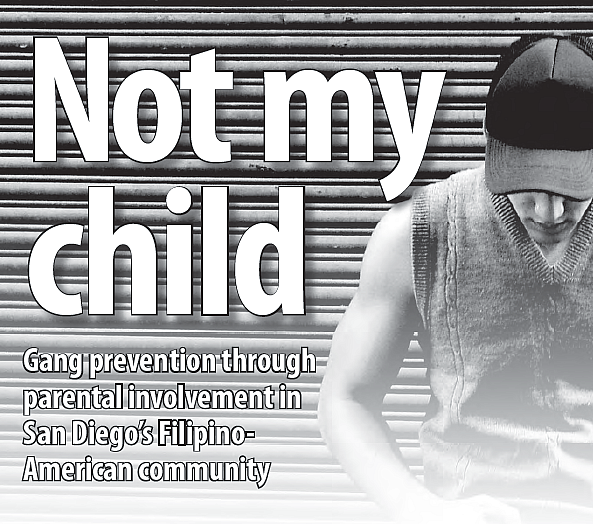Not My Child Part I
Alicia DeLeon-Torres explores common themes leading to youth gang involvement in the San Diego area.

Pureza Bacor recalls the Filipino father, a single parent, who called at 4:55 p.m. on a Friday afternoon. He spoke in hushed tones and in near tears.
“Do you speak Tagalog? I can speak in English but what I need to say, I can’t express myself right in English. I need to speak to someone who speaks to Tagalog,” pleaded the father.
Bacor continued the conversation in Tagalog and after almost an hour of listening to his anguish, she promised to meet with him and his eldest son, who had been arrested by San Diego Police gang unit detectives earlier in the week. The father met Bacor at the door of his modest Mira Mesa home. He began the conversation with cultural pleasantries: From where in the Philippines does her family come from? How long have they been in the United States? What do they do for a living? Do her parents know so and so? Where did she go to school? What was her major? How did she get into social services and working with youth in trouble? Does she know so and so? Was she hungry? Was she thirsty? He offered her food.
Bacor knew the drill. To work in the Filipino community, you had to go through a cultural “dance” of introductions to find commonalities so there would be a smoother and more trusting foundation to begin a relationship. Even though she wasn’t hungry, she knew she had to take the food so she wouldn’t seem ungrateful and, not wanting to socialize, to bond. She sat for what she knew would be a long, tedious unraveling of the “real” story from the father’s point of view, then theson. She knew that somewhere in the middle of their story was the beginning of the truth.
The father worked the graveyard shift at Sony. He left his sons in care of a friend, but the friend worked the swing shift and there was a daily gap in time when his sons were left to themselves, usually after school. This is when the elder son and his friends would hang out at his house, watch TV, listen to music, talk and do their homework. The father seemed to feel guilty for not having more supervision for his sons. He thought things wouldbe OK because they were all “good boys,” but he knew some of his sons’ friends may not be so “upstanding.”
One night, a group of boys drove by their house and shot out the living room window, parts of front door, the facade and the garage door. Luckily no one was hit. The group retaliated. Everyone was arrested — including his son.
The father insisted his son didn’t know what was going to happen. He looked at his eldest, who sat politely and nodded with every point his father made.
Even though that was eight years ago, the case stuck with her. At the time, Bacor was the director of the Asian Pacific Islander High Risk Youth Mentorship Program at the Union of Pan Asian Communities. She remembers the elder son finally confessing to her, but not his father that he did belong to a Mira Mesa gang. She remembers talking to the younger siblings about what they thought about gangs. The middle son seemed interested only in video games and the younger was a “skater boy.” The older son ensured Bacor that his brothers would not follow his path.
They weren’t like him. He shared his plans about joining the Navy upon graduation “in a couple of years.” She remembers thinking “how Filipino it was” that amidst crisis, he was still thinking about the future. She remembers speaking to the gang detectives and some of his friends to get a larger understanding of the situation with this particular young man and his family. They all gave different viewpoints on him and his activities; not one story matched, except that he was a nice guy who was polite to his elders and attended school regularly.
Back then, Bacor and two other staff members provided mentorship and gang prevention services for much of San Diego County’s Asian-American and Pacific Islander youth who were at high risk of gang involvement and other illicit activities. They were constantly busy with referrals from the police department, probation, other social service providers and parents. Bacor, like many other youth service providers were given the same training by “experts” from law enforcement and researchers.
They all said that Filipino gang members were different in many ways — they didn’t follow the same rules as gang members of other ethnicities; they came from largely two parent homes; they were mostly from middleclass and upper middle-class backgrounds; they earned good grades in school; Filipino parents were very unaware of signs their sons or daughter might be involved in gangs; and they were going through a phase that they would eventually out grow it.
Today’s growing list of experts train on the same points, emphasizing that Filipino youth would grow out of the gang stage. Unfortunately, they didn’t take into account siblings “growing into” the same gang their older brother or sister grew out of. Bacor is currently program director of the Los Angelesbased STAR Education, an after- school program, but she still hears about many of her former clients, including the family in Mira Mesa.
“The eldest son did join the Navy,” she said. “When he left, the middle brother took his place in the gang. He was arrested for crimes committed. The younger brother then took the middle brother’s place in the same gang.” Bacor sighed. “The experts need to change their training and need to fully understand our kids, our families and our community,” she said. “Parents need to wake up. The kids need to think through their actions. The situation won’t get any better if things don’t change.”

